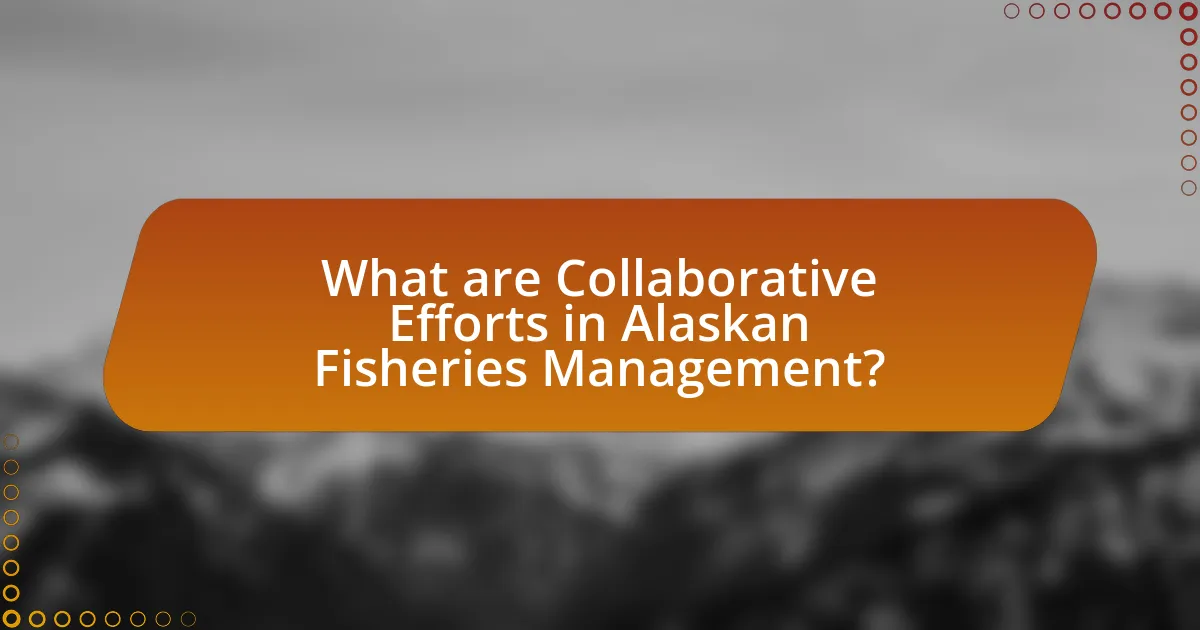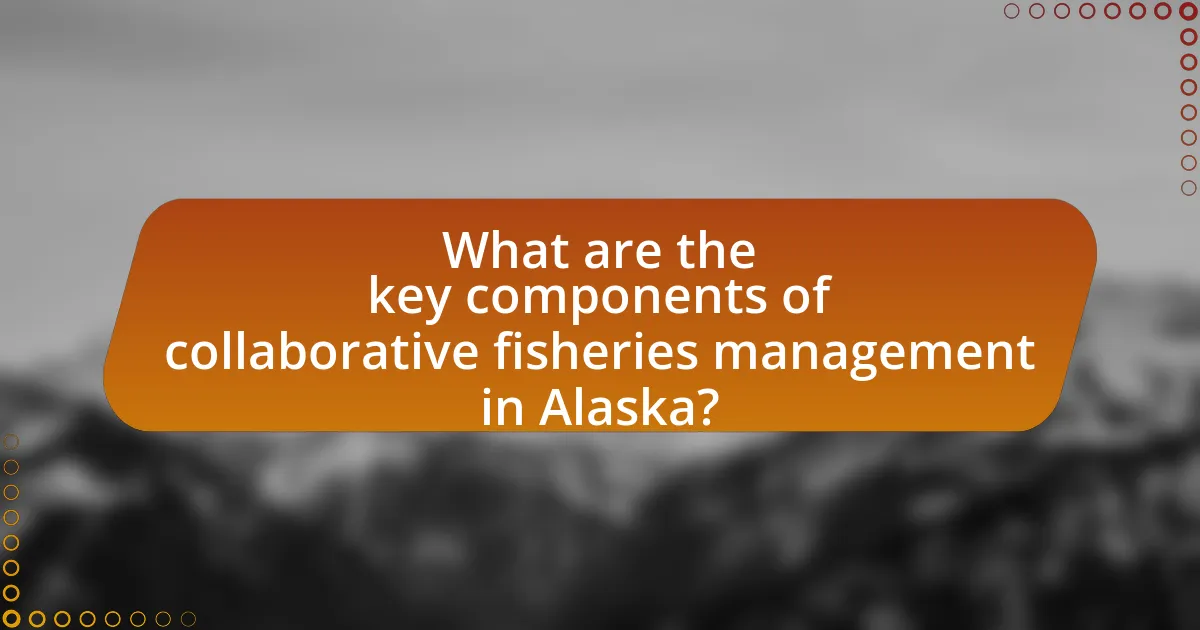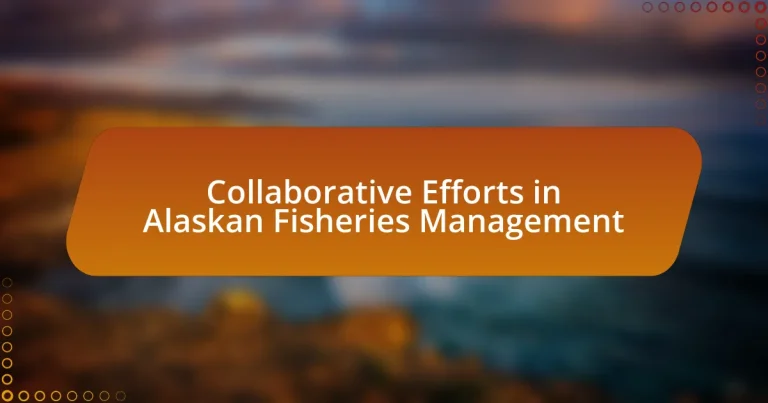Collaborative efforts in Alaskan fisheries management involve partnerships among government agencies, local communities, scientists, and industry representatives aimed at ensuring sustainable fishing practices. The North Pacific Fishery Management Council plays a pivotal role in facilitating stakeholder engagement through public meetings and advisory committees, integrating traditional ecological knowledge with scientific research. This collaborative approach has led to improved fish stock assessments, effective conservation measures, and enhanced economic viability of fisheries, demonstrating the importance of diverse stakeholder perspectives in managing Alaska’s marine resources. Key components of these collaborations include co-management frameworks, data sharing, and adaptive management practices that collectively contribute to the sustainability of fisheries in the region.

What are Collaborative Efforts in Alaskan Fisheries Management?
Collaborative efforts in Alaskan fisheries management involve partnerships among various stakeholders, including government agencies, local communities, scientists, and industry representatives, to ensure sustainable fishery practices. These collaborations aim to integrate traditional ecological knowledge with scientific research, enhancing decision-making processes. For instance, the North Pacific Fishery Management Council engages stakeholders through public meetings and advisory committees, allowing for input on regulations and management strategies. This approach has led to more effective conservation measures and improved fish stock assessments, demonstrating the value of collective input in managing Alaska’s rich marine resources.
How do stakeholders collaborate in Alaskan fisheries management?
Stakeholders in Alaskan fisheries management collaborate through structured processes that involve various groups, including government agencies, local communities, commercial and recreational fishers, and conservation organizations. This collaboration is facilitated by the North Pacific Fishery Management Council, which engages stakeholders in decision-making processes, ensuring that diverse perspectives are considered in the management of fishery resources.
For instance, the Council conducts public meetings and workshops where stakeholders can provide input on fishery regulations and management strategies. Additionally, the use of advisory panels composed of industry representatives and scientists helps to integrate scientific research with practical fishing knowledge, enhancing the effectiveness of management decisions.
The effectiveness of this collaborative approach is evidenced by the sustainable management practices that have led to the recovery of several fish stocks in Alaskan waters, demonstrating the positive outcomes of stakeholder engagement in fisheries management.
What roles do government agencies play in these collaborations?
Government agencies play crucial roles in collaborations for Alaskan fisheries management by providing regulatory oversight, funding, and scientific research. These agencies, such as the National Oceanic and Atmospheric Administration (NOAA) and the Alaska Department of Fish and Game, establish policies that ensure sustainable fishing practices and protect marine ecosystems. For instance, NOAA’s Fisheries Service implements regulations based on scientific assessments to manage fish stocks effectively, which is essential for maintaining the balance between ecological health and economic viability. Additionally, government agencies facilitate stakeholder engagement, bringing together fishermen, conservationists, and local communities to collaboratively address challenges and develop management strategies. This collaborative approach is supported by data from the North Pacific Fishery Management Council, which emphasizes the importance of stakeholder input in decision-making processes.
How do local communities contribute to fisheries management efforts?
Local communities contribute to fisheries management efforts by actively participating in decision-making processes and implementing sustainable practices. These communities often possess traditional ecological knowledge that informs management strategies, ensuring that local conditions and species behaviors are considered. For instance, in Alaska, local fishers collaborate with state agencies to monitor fish populations and habitats, leading to more effective conservation measures. Research indicates that community-based management approaches can enhance compliance with regulations and improve fishery outcomes, as seen in the successful management of halibut and salmon stocks in Alaskan waters.
Why is collaboration important in managing Alaskan fisheries?
Collaboration is crucial in managing Alaskan fisheries because it ensures the integration of diverse stakeholder perspectives, leading to more effective and sustainable management practices. In Alaska, fisheries involve various stakeholders, including local communities, commercial fishers, scientists, and government agencies, all of whom contribute unique knowledge and expertise. For instance, the North Pacific Fishery Management Council employs a collaborative approach that incorporates scientific research and local ecological knowledge, resulting in more informed decision-making. This collaborative framework has been shown to enhance compliance with regulations and improve the resilience of fish stocks, as evidenced by the recovery of several overfished species in the region.
What challenges do fisheries face that necessitate collaborative approaches?
Fisheries face overfishing, habitat degradation, and climate change, which necessitate collaborative approaches for effective management. Overfishing depletes fish stocks, leading to economic instability and ecological imbalance, while habitat degradation from pollution and development further threatens marine ecosystems. Climate change alters fish migration patterns and affects breeding cycles, complicating resource management. Collaborative efforts among stakeholders, including government agencies, local communities, and scientists, are essential to develop sustainable practices, share data, and implement adaptive management strategies that address these interconnected challenges.
How does collaboration enhance sustainability in fisheries management?
Collaboration enhances sustainability in fisheries management by fostering shared decision-making among stakeholders, which leads to more effective resource management. In Alaskan fisheries, collaborative efforts among fishermen, scientists, and regulatory agencies have resulted in data-driven policies that consider ecological, economic, and social factors. For instance, the North Pacific Fishery Management Council employs a collaborative approach that integrates local knowledge with scientific research, ensuring that fish stocks are managed sustainably while supporting local communities. This synergy not only improves compliance with regulations but also promotes adaptive management practices that respond to changing environmental conditions, thereby reinforcing the long-term viability of fisheries.

What are the key components of collaborative fisheries management in Alaska?
The key components of collaborative fisheries management in Alaska include stakeholder engagement, co-management frameworks, data sharing, and adaptive management practices. Stakeholder engagement involves the active participation of local communities, fishers, and regulatory agencies in decision-making processes, ensuring that diverse perspectives are considered. Co-management frameworks establish partnerships between state and federal agencies and local entities, facilitating shared responsibility for resource management. Data sharing is critical for informed decision-making, as it allows stakeholders to access and utilize scientific research and local knowledge. Adaptive management practices enable the continuous adjustment of strategies based on monitoring outcomes and changing environmental conditions, ensuring sustainable fisheries management. These components collectively enhance the effectiveness and sustainability of fisheries in Alaska.
What types of partnerships exist in Alaskan fisheries management?
In Alaskan fisheries management, there are several types of partnerships, including government partnerships, industry collaborations, and community-based organizations. Government partnerships involve federal and state agencies working together to establish regulations and manage fish stocks sustainably. Industry collaborations consist of fishing companies and associations joining forces to promote best practices and ensure economic viability. Community-based organizations engage local stakeholders, including indigenous groups, to incorporate traditional knowledge and local needs into management strategies. These partnerships are essential for effective resource management and conservation efforts in Alaska’s diverse fisheries.
How do public-private partnerships function in this context?
Public-private partnerships in the context of Alaskan fisheries management function by combining resources and expertise from both sectors to enhance sustainability and economic viability. These partnerships facilitate collaborative decision-making, where government agencies and private stakeholders, such as fishing companies and conservation organizations, work together to develop and implement management strategies. For example, the North Pacific Fishery Management Council engages in partnerships with industry representatives to gather data and assess fish stocks, ensuring that regulations are based on scientific evidence and stakeholder input. This collaborative approach has led to more effective management practices, as evidenced by the recovery of several fish populations in Alaskan waters, demonstrating the success of integrating public and private efforts in fisheries management.
What is the role of non-governmental organizations in fisheries management?
Non-governmental organizations (NGOs) play a crucial role in fisheries management by advocating for sustainable practices, influencing policy, and facilitating stakeholder engagement. NGOs often conduct research and provide data that inform management decisions, ensuring that ecological, economic, and social factors are considered. For instance, organizations like the Marine Conservation Society have been instrumental in promoting sustainable fishing practices and raising awareness about overfishing. Their efforts contribute to the development of regulations that protect fish stocks and marine ecosystems, demonstrating the significant impact NGOs have on effective fisheries management.
What frameworks support collaboration among stakeholders?
Collaborative frameworks that support stakeholder collaboration in Alaskan fisheries management include the Alaska Sustainable Fisheries Task Force and the North Pacific Fishery Management Council. These frameworks facilitate communication and decision-making among various stakeholders, including fishermen, government agencies, and conservation groups. The Alaska Sustainable Fisheries Task Force, established in 1998, aims to enhance the sustainability of fisheries through stakeholder engagement and collaborative governance. The North Pacific Fishery Management Council, responsible for managing fishery resources in federal waters off Alaska, incorporates stakeholder input in its decision-making processes, ensuring that diverse perspectives are considered. These frameworks are essential for fostering cooperation and achieving sustainable fisheries management in Alaska.
How do regulatory frameworks influence collaborative efforts?
Regulatory frameworks significantly influence collaborative efforts by establishing the legal and operational parameters within which stakeholders operate. In Alaskan fisheries management, these frameworks dictate the roles and responsibilities of various entities, including government agencies, local communities, and industry representatives. For instance, the Magnuson-Stevens Fishery Conservation and Management Act provides guidelines for sustainable fishing practices, which necessitate collaboration among stakeholders to ensure compliance and resource conservation. This legal structure fosters partnerships by aligning the interests of different parties towards common goals, such as maintaining fish populations and supporting local economies. Furthermore, regulatory frameworks often include provisions for stakeholder engagement, which enhances transparency and trust, thereby facilitating more effective collaboration.
What best practices have emerged from successful collaborations?
Best practices that have emerged from successful collaborations in Alaskan fisheries management include establishing clear communication channels, fostering trust among stakeholders, and involving local communities in decision-making processes. Clear communication ensures that all parties are informed and aligned on objectives, which is critical for effective collaboration. Trust among stakeholders, built through transparency and consistent engagement, enhances cooperation and commitment to shared goals. Involving local communities leverages traditional knowledge and promotes sustainable practices, as evidenced by the success of the North Pacific Fishery Management Council, which incorporates community input into management strategies. These practices have been shown to lead to more effective and sustainable fisheries management outcomes.

What are the outcomes of collaborative efforts in Alaskan fisheries management?
Collaborative efforts in Alaskan fisheries management have led to improved sustainability and enhanced fish stock recovery. These partnerships, involving stakeholders such as local communities, government agencies, and scientists, have facilitated data sharing and adaptive management practices. For instance, the establishment of the North Pacific Fishery Management Council has resulted in more effective regulations that consider ecological, economic, and social factors, leading to a 50% increase in the biomass of key fish species like Pacific cod since the 1990s. Additionally, collaborative initiatives have fostered community engagement, ensuring that local knowledge informs management decisions, which has been crucial for the resilience of fisheries in the face of climate change.
How do collaborative efforts impact fish populations and ecosystems?
Collaborative efforts significantly enhance fish populations and ecosystems by promoting sustainable management practices and fostering stakeholder engagement. In Alaskan fisheries management, partnerships among government agencies, local communities, and scientists lead to more effective resource allocation and conservation strategies. For instance, the North Pacific Fishery Management Council employs collaborative approaches that integrate scientific research with local knowledge, resulting in improved stock assessments and healthier fish populations. Studies indicate that regions with collaborative management frameworks experience higher biodiversity and resilience in marine ecosystems, as evidenced by the recovery of overfished species in Alaska due to cooperative regulations and monitoring efforts.
What evidence exists to support the effectiveness of these collaborations?
Evidence supporting the effectiveness of collaborations in Alaskan fisheries management includes improved fish stock assessments and enhanced stakeholder engagement. For instance, the North Pacific Fishery Management Council’s collaborative approach has led to more accurate data collection, resulting in sustainable fishery practices. Additionally, studies such as the one conducted by the Alaska Sea Grant program demonstrate that stakeholder involvement in decision-making processes has increased compliance with regulations and improved resource management outcomes. These findings indicate that collaborative efforts significantly contribute to the sustainability and health of Alaskan fisheries.
How do collaborative efforts affect the economic viability of fisheries?
Collaborative efforts enhance the economic viability of fisheries by promoting sustainable practices and resource sharing among stakeholders. In Alaskan fisheries management, collaboration among fishermen, scientists, and regulatory bodies leads to better data collection and informed decision-making, which helps maintain fish populations and ecosystems. For instance, the North Pacific Fishery Management Council employs a cooperative approach that has resulted in the recovery of overfished stocks, thereby increasing catch limits and economic returns for the fishing industry. This collaborative framework not only supports long-term sustainability but also fosters community resilience and economic stability in coastal regions reliant on fisheries.
What lessons can be learned from successful collaborative initiatives?
Successful collaborative initiatives in Alaskan fisheries management demonstrate the importance of stakeholder engagement, adaptive management, and shared goals. Engaging diverse stakeholders, including local communities, government agencies, and scientists, fosters trust and enhances decision-making processes. For instance, the North Pacific Fishery Management Council effectively incorporates input from various groups, leading to more sustainable practices. Adaptive management allows for flexibility in response to changing environmental conditions, as seen in the implementation of the Ecosystem-Based Fishery Management approach. Additionally, establishing shared goals among stakeholders aligns efforts and resources, which has been crucial in initiatives like the Bering Sea Aleutian Islands fishery management plan. These lessons highlight that collaboration enhances sustainability and resilience in fisheries management.
How can these lessons be applied to improve future fisheries management?
Lessons from collaborative efforts in Alaskan fisheries management can be applied to improve future fisheries management by emphasizing stakeholder engagement and adaptive management strategies. Engaging local communities, fishers, and scientists fosters a shared responsibility for resource stewardship, which has been shown to enhance compliance and sustainability. For instance, the North Pacific Fishery Management Council’s approach to incorporating local knowledge and scientific data has led to more effective stock assessments and management decisions. Additionally, adaptive management allows for flexibility in response to changing environmental conditions and fish populations, as demonstrated by the successful implementation of catch shares in various fisheries, which has resulted in increased fish stocks and economic benefits.
What practical strategies can enhance collaboration in Alaskan fisheries management?
Practical strategies that can enhance collaboration in Alaskan fisheries management include establishing stakeholder forums, implementing co-management agreements, and utilizing data-sharing platforms. Stakeholder forums facilitate open communication among fishermen, scientists, and policymakers, allowing for diverse perspectives and shared decision-making. Co-management agreements empower local communities by involving them in the management process, which has been shown to improve compliance and sustainability outcomes. Data-sharing platforms enhance transparency and trust among stakeholders, enabling real-time access to critical information, which is essential for informed decision-making. These strategies are supported by successful case studies in Alaskan fisheries, demonstrating improved resource management and stakeholder engagement.
How can communication be improved among stakeholders?
Communication among stakeholders can be improved by implementing structured dialogue platforms that facilitate regular interaction and feedback. These platforms, such as stakeholder meetings and online forums, allow for the exchange of information and perspectives, fostering transparency and trust. Research indicates that effective communication strategies, including the use of visual aids and clear agendas, enhance understanding and engagement among diverse groups (Berkes, 2009, “Evolution of Co-Management: Role of Local Knowledge in Fisheries Management”). By prioritizing inclusive communication practices, stakeholders can better align their goals and collaboratively address challenges in Alaskan fisheries management.
What tools and technologies can facilitate better collaboration?
Tools and technologies that can facilitate better collaboration in Alaskan fisheries management include collaborative software platforms, data-sharing systems, and communication tools. Collaborative software platforms like Microsoft Teams and Slack enable real-time communication and project management among stakeholders. Data-sharing systems, such as Geographic Information Systems (GIS) and cloud-based databases, allow for the integration and analysis of fisheries data, enhancing decision-making processes. Communication tools, including video conferencing applications like Zoom, support remote meetings and discussions, fostering engagement among diverse groups. These technologies collectively improve transparency, streamline workflows, and enhance stakeholder participation in fisheries management initiatives.


